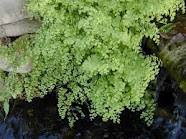Maidenhair ferns grow around the world, but this one is also called the True Maidenhair which is native to southern Europe and seems to be indigenous to parts of the British Isles and western Ireland
 The fronds of the Maidenhair fern are gossamer-like, and the leaves of the ginkgo biloba tree resemble these closely. They must have been though to resemble hair, or perhaps Linnaeus gave it the botanical name capillus because it was once though to work as a hair restorer. The Latin name Adiantum means “unwetted” while capillus-veneris means “hair of Venus.” It belongs to the Polypodiaceae (many-footed) family of plants and can grow in its natural state to heights of one foot and can be one foot or a little more across.
The fronds of the Maidenhair fern are gossamer-like, and the leaves of the ginkgo biloba tree resemble these closely. They must have been though to resemble hair, or perhaps Linnaeus gave it the botanical name capillus because it was once though to work as a hair restorer. The Latin name Adiantum means “unwetted” while capillus-veneris means “hair of Venus.” It belongs to the Polypodiaceae (many-footed) family of plants and can grow in its natural state to heights of one foot and can be one foot or a little more across. The above ground parts have been used in traditional medicine at least since the Greeks used it as an expectorant for coughs. Mediaeval herbalists used it for respiratory problems and it has been combined with King’s clover in an infusion to treat varicose veins and arteriosclerosis. Combined with the Greater Periwinkle or lime flowers it was used for blood circulation problems. The infusion of the fronds is said to be a good treatment or dandruff and similar scalp problems. The seeds have been used with Elecampane or mulberry leaves to treat asthma and coughs too.
Maidenhair fern contains coumarins, the bioflavonoids, rutin and isoquercetin among others, and terpenoids along with other substances. In France
John Gerard, the English herbalist who wrote in the 16th century has this to say about the plant:-
Gerard writes of it:
'It consumeth and wasteth away the King's Evil and other hard swellings, and it maketh the haire of the head or beard to grow that is fallen and pulled off.'
Culpeper, writing in the 17th century writes of the fern in this way: -
“This and all other Maiden Hairs is a good remedy for coughs, asthmas, pleurisy, etc., and on account of its being a gentle diuretic also in jaundice, gravel and other impurities of the kidneys. All the Maidenhairs should be used green and in conjunction with other ingredients because their virtues are weak.”
In some countries such as Nepal
 The fronds can be used fresh or gathered in summer and dried for later use. Apparently it has been used in poultices for insect and snake bites, but it doesn’t appear to have potent medicinal effects, at least in studies which have been conducted on it so far. The studies are inconclusive and contradictory in some cases. Besharat M et al, Dec 2008 “Antibacterial Effects of Adiantum capillus-veneris Ethanolic Extract of Three Pathogenic Bacteria In Vitro” Journal of Clinical and Diagnostic Research,1242-3, concluded “According to the ancient papers about medicinal herbs, this herb has antibacterial effects. Our result did not show this effect in ethanolic extract.”
The fronds can be used fresh or gathered in summer and dried for later use. Apparently it has been used in poultices for insect and snake bites, but it doesn’t appear to have potent medicinal effects, at least in studies which have been conducted on it so far. The studies are inconclusive and contradictory in some cases. Besharat M et al, Dec 2008 “Antibacterial Effects of Adiantum capillus-veneris Ethanolic Extract of Three Pathogenic Bacteria In Vitro” Journal of Clinical and Diagnostic Research,1242-3, concluded “According to the ancient papers about medicinal herbs, this herb has antibacterial effects. Our result did not show this effect in ethanolic extract.” Of course, experiments with other types of extract and bacteria could have different results. Majid Alipour and Omid Khanmohammadi, 23rd September 2011 , “Antibacterial activity of plant extracts against oral and skin pathogens”: African Journal of Microbiology Research Vol. 5 (19); pp 2909-11, state in their conclusion that Adiantum capillus-veneris showed “antibacterial activity against S. (Streptococcus) pyrogenes and S. aureus” and suggested that it could be used instead of penicillin against these bacteria. Streptococcus pyrogenes is the bacteria which is responsible for rheumatic fever.
Other researchers have mad different claims for the efficacy of this plant and its traditional medicinal uses, but these have not been thoroughly tested in other trials.
MAIDENHAIR FERN TISANE
Ingredients
1 cup of maidenhair fern leaves, snipped finely
2 cups boiling water
a little honey to sweeten
Method
Pour the boiling water over the leaves and leave to steep for 20 minutes. Strain, sweeten with honey and drink a small cupful 3 times a day.
Do not use for prolonged periods of time, only for the short duration of a cough or cold.
Without the addition of honey this can be used externally to relive the pain associated with varicose veins too, and can be rubbed into the scalp to get rid of dandruff.
This has Taste and is a Treat(ment).






